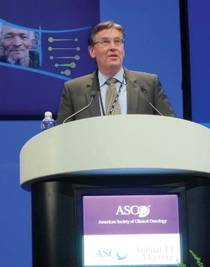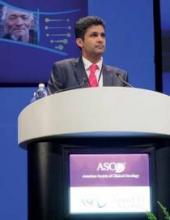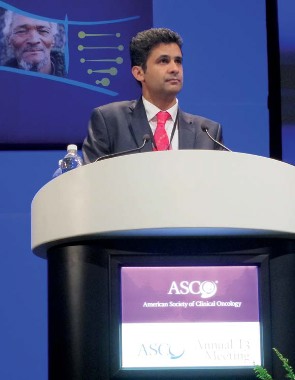User login
CHICAGO – Dose-dense chemotherapy reduced the risk of progression or death by 34% compared with standard therapy in young patients who had poor-risk germ cell tumors with unfavorable tumor marker decline in the phase III GETUG 13 trial.
Neurotoxicity was increased, but manageable. There was no excess of second cancers, as observed in other trials. And the overall survival rate after 3 years now exceeds 75% in these patients with poor-prognosis disease.
"The dose-dense regimen should become the new standard treatment for these patients with poor-risk disease and slow tumor marker decline," Dr. Karim Fizazi, with the Institut Gustave Roussy, Villejuif, France, said at the meeting.
For patients with poor-prognosis germ cell tumors, the standard treatment – involving four cycles of bleomycin, etoposide and cisplatin (BEP) chemotherapy – was established in 1987. Over the last decade, the prognostic role of tumor marker decline has been demonstrated, but all of the phase III trials in the last 25 years have reported negative results and 48% of patients achieve a cure at 5 years, he said.
The GETUG (Genitourinary Tumor Group) 13 investigators hypothesized that personalized treatment, including individualized cumulative doses of bleomycin, should be used only for patients with early unfavorable tumor marker decline; that paclitaxel, ifosfamide, and increased oxaliplatin dose intensity would have an incremental and small benefit in the first-line setting; and that toxic deaths from neutropenic fever and secondary leukemia could be prevented through the use of granulocyte colony-stimulating factor (G-CSF) and capping etoposide at 2 g/m2.
In all, 263 patients with various poor-risk germ cell tumors were enrolled, and 254 underwent tumor marker analysis on day 21 after the first cycle of BEP. Of these, 51 patients with favorable tumor decline continued on BEP for a total of four courses, and 203 patients with unfavorable tumor decline were randomized to continue on BEP for a total of four courses (n = 105) or to receive a dose-dense regimen (n = 98) consisting of paclitaxel-BEP plus oxaliplatin 130 mg/m2 on day 10 for two cycles, followed by two cycles of cisplatin 100 mg on day 1; ifosfamide 2 mg/m2 on days 10, 12, and 14; and continuous-infusion bleomycin 25 U/d on days 10-14. The trial was amended so all patients received G-CSF support. Oxaliplatin was deleted from cycles 3-4 of the dose-dense regimen after excess neurotoxicity was observed in the first 10 patients, Dr. Fizazi said.
Tumor marker decline was calculated using a logarithmic formula (J. Clin. Oncol. 2004;22:3868-76).
At 3 years, the primary endpoint of progression-free survival was 59% in the dose-dense group and 48% in the unfavorable tumor decline group randomized to BEP (hazard ratio, 0.66; P = .05), Dr. Fizazi said. At last follow-up, 63 patients in the dose-dense group were alive and continuously free of progression, compared with 46 in the BEP unfavorable group.
Progression-free survival favored the dose-dense regimen in all subgroups tested, with patients with mediastinal primary or extrapulmonary visceral metastases tending to benefit more, he said.
There was a nonsignificant trend for overall survival in patients receiving the dose-dense regimen, with 3-year rates of 73% in the dose-dense group and 65% in the unfavorable BEP arm (HR 0.78; P = .34).
Toxicities in the dose-dense and BEP groups were comparable for neutropenic fever (17% in both), toxic deaths (1% in both), and second cancers (1% vs. 4%). Patients in the dose-dense arm experienced more neurotoxicities that were grade 2 or higher (23% vs. 4%), and they were significantly less likely to undergo salvage high-dose chemotherapy and transplant (6% vs. 16%; P = .01), Dr. Fizazi said.
The prognostic value of tumor marker decline was again demonstrated in outcome comparisons, he said. At 3 years, the favorable BEP group, as compared with the unfavorable BEP group, had significantly better rates of progression-free survival (70% vs. 48%; HR, 0.66; P = .01) and overall survival (84% vs. 65%; HR, 0.65; P = .02).
The study was sponsored by the University of Texas M.D. Anderson Cancer Center, Houston, and by Unicancer in Europe, with support from Institut National du Cancer, Ligue Nationale contre le Cancer, Sanofi-Aventis, Chugai, Baxter, and Faulding Pharmaceuticals. Dr. Fizazi and Dr. Bokemeyer reported no relevant disclosures.
GETUG 13 is the first randomized trial showing an effect of dose intensification in slow tumor marker decline patients, and it clearly shows the importance of tumor marker decline as a prognostic treatment factor.
Marker decline only partially correlates with poor risk features, but it can be assessed after just one cycle using the French algorithm. That’s important. If we want to change a treatment strategy, we can do it early.
 |
Patrice Wendling/IMNG Medical Media
|
The study’s dose-dense regimen is somewhat unusual, however, and it’s not clear whether it will be considered a standard by other germ cell tumor groups or whether there are other, better options for dose-intensified therapy such as high-dose CEC (carboplatin, etoposide, and cyclophosphamide) or PEI (cisplatin, etoposide, and ifosfamide), accelerated BEP, or even TIP (paclitaxel, ifosfamide, and cisplatin).
As for whether dose-dense chemotherapy should become the new standard, the final conclusions from this trial with regard to guideline inclusion need more than one discussant.
Dr. Carsten Bokemeyer is the director of the University Cancer Center Hamburg, University Hospital Hamburg-Eppendorf (Germany). Dr. Bokemeyer was the invited discussant of the study at the meeting. He reported no relevant disclosures.
GETUG 13 is the first randomized trial showing an effect of dose intensification in slow tumor marker decline patients, and it clearly shows the importance of tumor marker decline as a prognostic treatment factor.
Marker decline only partially correlates with poor risk features, but it can be assessed after just one cycle using the French algorithm. That’s important. If we want to change a treatment strategy, we can do it early.
 |
Patrice Wendling/IMNG Medical Media
|
The study’s dose-dense regimen is somewhat unusual, however, and it’s not clear whether it will be considered a standard by other germ cell tumor groups or whether there are other, better options for dose-intensified therapy such as high-dose CEC (carboplatin, etoposide, and cyclophosphamide) or PEI (cisplatin, etoposide, and ifosfamide), accelerated BEP, or even TIP (paclitaxel, ifosfamide, and cisplatin).
As for whether dose-dense chemotherapy should become the new standard, the final conclusions from this trial with regard to guideline inclusion need more than one discussant.
Dr. Carsten Bokemeyer is the director of the University Cancer Center Hamburg, University Hospital Hamburg-Eppendorf (Germany). Dr. Bokemeyer was the invited discussant of the study at the meeting. He reported no relevant disclosures.
GETUG 13 is the first randomized trial showing an effect of dose intensification in slow tumor marker decline patients, and it clearly shows the importance of tumor marker decline as a prognostic treatment factor.
Marker decline only partially correlates with poor risk features, but it can be assessed after just one cycle using the French algorithm. That’s important. If we want to change a treatment strategy, we can do it early.
 |
Patrice Wendling/IMNG Medical Media
|
The study’s dose-dense regimen is somewhat unusual, however, and it’s not clear whether it will be considered a standard by other germ cell tumor groups or whether there are other, better options for dose-intensified therapy such as high-dose CEC (carboplatin, etoposide, and cyclophosphamide) or PEI (cisplatin, etoposide, and ifosfamide), accelerated BEP, or even TIP (paclitaxel, ifosfamide, and cisplatin).
As for whether dose-dense chemotherapy should become the new standard, the final conclusions from this trial with regard to guideline inclusion need more than one discussant.
Dr. Carsten Bokemeyer is the director of the University Cancer Center Hamburg, University Hospital Hamburg-Eppendorf (Germany). Dr. Bokemeyer was the invited discussant of the study at the meeting. He reported no relevant disclosures.
CHICAGO – Dose-dense chemotherapy reduced the risk of progression or death by 34% compared with standard therapy in young patients who had poor-risk germ cell tumors with unfavorable tumor marker decline in the phase III GETUG 13 trial.
Neurotoxicity was increased, but manageable. There was no excess of second cancers, as observed in other trials. And the overall survival rate after 3 years now exceeds 75% in these patients with poor-prognosis disease.
"The dose-dense regimen should become the new standard treatment for these patients with poor-risk disease and slow tumor marker decline," Dr. Karim Fizazi, with the Institut Gustave Roussy, Villejuif, France, said at the meeting.
For patients with poor-prognosis germ cell tumors, the standard treatment – involving four cycles of bleomycin, etoposide and cisplatin (BEP) chemotherapy – was established in 1987. Over the last decade, the prognostic role of tumor marker decline has been demonstrated, but all of the phase III trials in the last 25 years have reported negative results and 48% of patients achieve a cure at 5 years, he said.
The GETUG (Genitourinary Tumor Group) 13 investigators hypothesized that personalized treatment, including individualized cumulative doses of bleomycin, should be used only for patients with early unfavorable tumor marker decline; that paclitaxel, ifosfamide, and increased oxaliplatin dose intensity would have an incremental and small benefit in the first-line setting; and that toxic deaths from neutropenic fever and secondary leukemia could be prevented through the use of granulocyte colony-stimulating factor (G-CSF) and capping etoposide at 2 g/m2.
In all, 263 patients with various poor-risk germ cell tumors were enrolled, and 254 underwent tumor marker analysis on day 21 after the first cycle of BEP. Of these, 51 patients with favorable tumor decline continued on BEP for a total of four courses, and 203 patients with unfavorable tumor decline were randomized to continue on BEP for a total of four courses (n = 105) or to receive a dose-dense regimen (n = 98) consisting of paclitaxel-BEP plus oxaliplatin 130 mg/m2 on day 10 for two cycles, followed by two cycles of cisplatin 100 mg on day 1; ifosfamide 2 mg/m2 on days 10, 12, and 14; and continuous-infusion bleomycin 25 U/d on days 10-14. The trial was amended so all patients received G-CSF support. Oxaliplatin was deleted from cycles 3-4 of the dose-dense regimen after excess neurotoxicity was observed in the first 10 patients, Dr. Fizazi said.
Tumor marker decline was calculated using a logarithmic formula (J. Clin. Oncol. 2004;22:3868-76).
At 3 years, the primary endpoint of progression-free survival was 59% in the dose-dense group and 48% in the unfavorable tumor decline group randomized to BEP (hazard ratio, 0.66; P = .05), Dr. Fizazi said. At last follow-up, 63 patients in the dose-dense group were alive and continuously free of progression, compared with 46 in the BEP unfavorable group.
Progression-free survival favored the dose-dense regimen in all subgroups tested, with patients with mediastinal primary or extrapulmonary visceral metastases tending to benefit more, he said.
There was a nonsignificant trend for overall survival in patients receiving the dose-dense regimen, with 3-year rates of 73% in the dose-dense group and 65% in the unfavorable BEP arm (HR 0.78; P = .34).
Toxicities in the dose-dense and BEP groups were comparable for neutropenic fever (17% in both), toxic deaths (1% in both), and second cancers (1% vs. 4%). Patients in the dose-dense arm experienced more neurotoxicities that were grade 2 or higher (23% vs. 4%), and they were significantly less likely to undergo salvage high-dose chemotherapy and transplant (6% vs. 16%; P = .01), Dr. Fizazi said.
The prognostic value of tumor marker decline was again demonstrated in outcome comparisons, he said. At 3 years, the favorable BEP group, as compared with the unfavorable BEP group, had significantly better rates of progression-free survival (70% vs. 48%; HR, 0.66; P = .01) and overall survival (84% vs. 65%; HR, 0.65; P = .02).
The study was sponsored by the University of Texas M.D. Anderson Cancer Center, Houston, and by Unicancer in Europe, with support from Institut National du Cancer, Ligue Nationale contre le Cancer, Sanofi-Aventis, Chugai, Baxter, and Faulding Pharmaceuticals. Dr. Fizazi and Dr. Bokemeyer reported no relevant disclosures.
CHICAGO – Dose-dense chemotherapy reduced the risk of progression or death by 34% compared with standard therapy in young patients who had poor-risk germ cell tumors with unfavorable tumor marker decline in the phase III GETUG 13 trial.
Neurotoxicity was increased, but manageable. There was no excess of second cancers, as observed in other trials. And the overall survival rate after 3 years now exceeds 75% in these patients with poor-prognosis disease.
"The dose-dense regimen should become the new standard treatment for these patients with poor-risk disease and slow tumor marker decline," Dr. Karim Fizazi, with the Institut Gustave Roussy, Villejuif, France, said at the meeting.
For patients with poor-prognosis germ cell tumors, the standard treatment – involving four cycles of bleomycin, etoposide and cisplatin (BEP) chemotherapy – was established in 1987. Over the last decade, the prognostic role of tumor marker decline has been demonstrated, but all of the phase III trials in the last 25 years have reported negative results and 48% of patients achieve a cure at 5 years, he said.
The GETUG (Genitourinary Tumor Group) 13 investigators hypothesized that personalized treatment, including individualized cumulative doses of bleomycin, should be used only for patients with early unfavorable tumor marker decline; that paclitaxel, ifosfamide, and increased oxaliplatin dose intensity would have an incremental and small benefit in the first-line setting; and that toxic deaths from neutropenic fever and secondary leukemia could be prevented through the use of granulocyte colony-stimulating factor (G-CSF) and capping etoposide at 2 g/m2.
In all, 263 patients with various poor-risk germ cell tumors were enrolled, and 254 underwent tumor marker analysis on day 21 after the first cycle of BEP. Of these, 51 patients with favorable tumor decline continued on BEP for a total of four courses, and 203 patients with unfavorable tumor decline were randomized to continue on BEP for a total of four courses (n = 105) or to receive a dose-dense regimen (n = 98) consisting of paclitaxel-BEP plus oxaliplatin 130 mg/m2 on day 10 for two cycles, followed by two cycles of cisplatin 100 mg on day 1; ifosfamide 2 mg/m2 on days 10, 12, and 14; and continuous-infusion bleomycin 25 U/d on days 10-14. The trial was amended so all patients received G-CSF support. Oxaliplatin was deleted from cycles 3-4 of the dose-dense regimen after excess neurotoxicity was observed in the first 10 patients, Dr. Fizazi said.
Tumor marker decline was calculated using a logarithmic formula (J. Clin. Oncol. 2004;22:3868-76).
At 3 years, the primary endpoint of progression-free survival was 59% in the dose-dense group and 48% in the unfavorable tumor decline group randomized to BEP (hazard ratio, 0.66; P = .05), Dr. Fizazi said. At last follow-up, 63 patients in the dose-dense group were alive and continuously free of progression, compared with 46 in the BEP unfavorable group.
Progression-free survival favored the dose-dense regimen in all subgroups tested, with patients with mediastinal primary or extrapulmonary visceral metastases tending to benefit more, he said.
There was a nonsignificant trend for overall survival in patients receiving the dose-dense regimen, with 3-year rates of 73% in the dose-dense group and 65% in the unfavorable BEP arm (HR 0.78; P = .34).
Toxicities in the dose-dense and BEP groups were comparable for neutropenic fever (17% in both), toxic deaths (1% in both), and second cancers (1% vs. 4%). Patients in the dose-dense arm experienced more neurotoxicities that were grade 2 or higher (23% vs. 4%), and they were significantly less likely to undergo salvage high-dose chemotherapy and transplant (6% vs. 16%; P = .01), Dr. Fizazi said.
The prognostic value of tumor marker decline was again demonstrated in outcome comparisons, he said. At 3 years, the favorable BEP group, as compared with the unfavorable BEP group, had significantly better rates of progression-free survival (70% vs. 48%; HR, 0.66; P = .01) and overall survival (84% vs. 65%; HR, 0.65; P = .02).
The study was sponsored by the University of Texas M.D. Anderson Cancer Center, Houston, and by Unicancer in Europe, with support from Institut National du Cancer, Ligue Nationale contre le Cancer, Sanofi-Aventis, Chugai, Baxter, and Faulding Pharmaceuticals. Dr. Fizazi and Dr. Bokemeyer reported no relevant disclosures.
AT THE ASCO ANNUAL MEETING 2013
Major finding: At 3 years, the primary endpoint of progression-free survival in the dose-dense group was 59% vs. 48% in the unfavorable tumor decline group randomized to BEP (hazard ratio, 0.66; P = .05).
Data source: Randomized, phase III trial of 254 patients with poor-risk germ cell tumors.
Disclosures: The study was sponsored by the University of Texas M.D. Anderson Cancer Center, Houston, and by Unicancer in Europe, with support from Institut National du Cancer, Ligue Nationale contre le Cancer, Sanofi-Aventis, Chugai, Baxter, and Faulding Pharmaceuticals. Dr. Fizazi and Dr. Bokemeyer reported no relevant disclosures.

